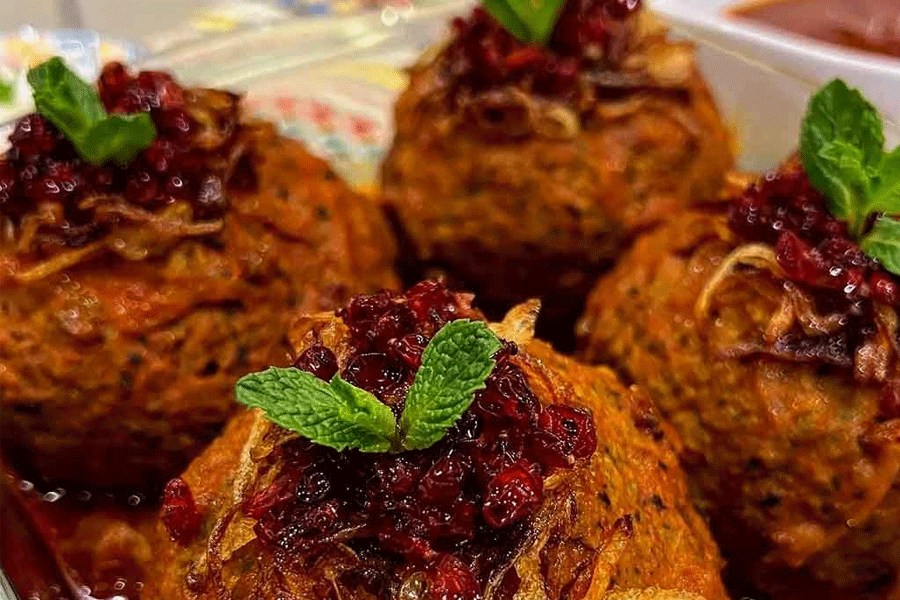
Top 20 Persian cuisines
Iran, a country rich in tradition, culture, and history, offers a wealth of exploration. Its diverse ethnicities and expansive landscapes provide endless stories to discover and delicious cuisines to savor.
You’ve probably heard about Iran’s stunning landscapes and natural beauty, as well as its must-see historical sites. To explore more about this fascinating country, please visit this address.
Let’s explore the flavorful world of Iranian cuisine. Just as Iran’s diverse landscapes and rich history offer a wealth of experiences, its food mirrors this variety. The country’s range of natural ingredients and cultural influences creates a vibrant and diverse culinary landscape.
Rest assured, Iranian cuisine has long been praised by travelers from around the world. They rave about the taste, aroma, freshness, and unique preparation methods of Iranian dishes. Throughout your trip to Iran, you’ll have the chance to indulge in delicious meals that will delight your palate and immerse you in Persian culture.
Top 10 Must-Try Iranian Dishes
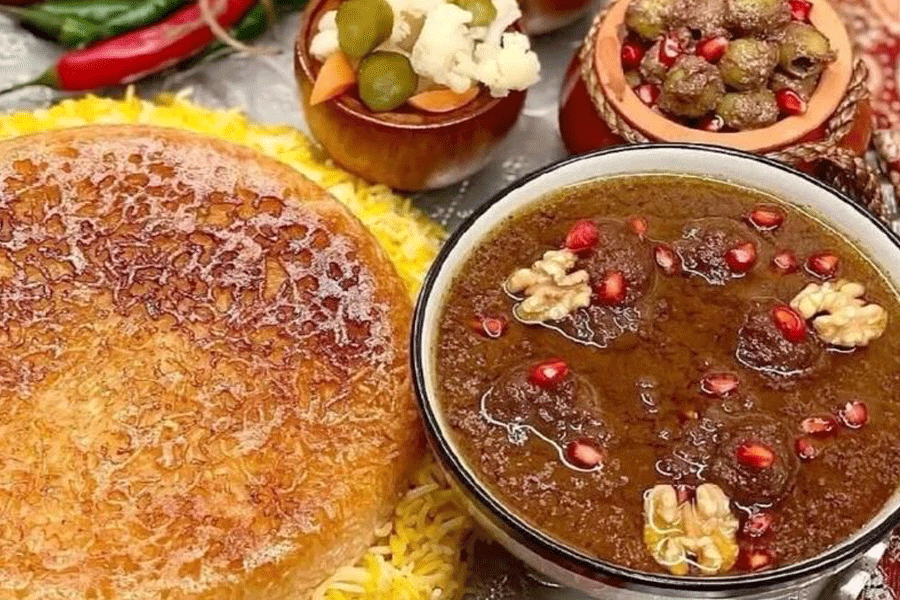
1. Khoresht-e Fesenjan
Fesenjan is a beloved Persian stew that has become a favorite at significant events like weddings. This rich and flavorful dish is made with ground walnuts, pomegranate paste, and typically chicken or meatballs. Originally from northern Iran, where it was traditionally prepared with duck, it is now more commonly enjoyed with chicken.
Though this stew requires hours of slow cooking, mastering the technique allows you to recreate its authentic flavor at home. Regional variations exist across Iran, with some versions leaning towards a sour taste due to added pomegranate syrup, while others may incorporate sugar for a sweeter flavor. The traditional recipe strikes a balance, with the pomegranate syrup adding depth without overwhelming sweetness or tartness.
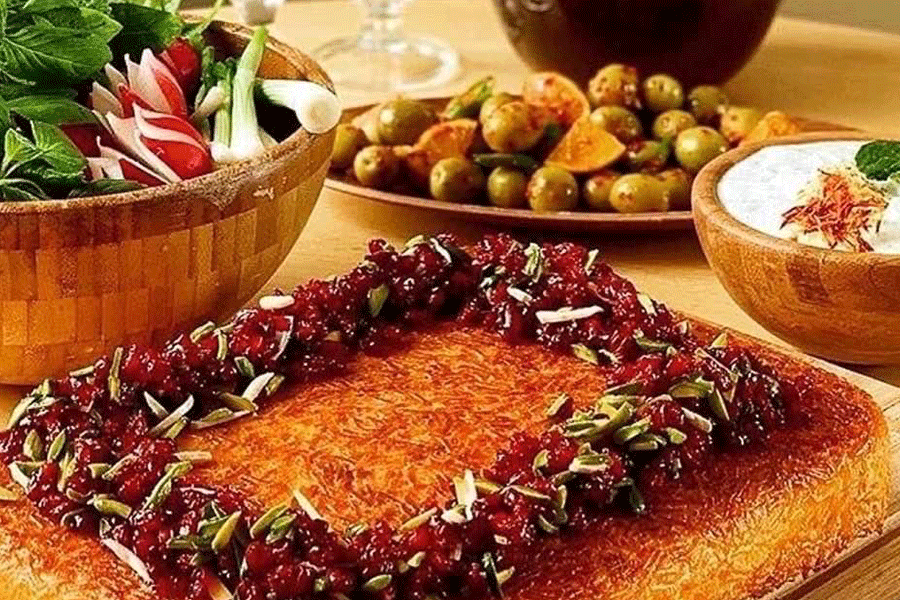
2. Zereshk Polo
A standout dish in Iranian cuisine, Zereshk Polo is often featured at special occasions and is commonly paired with chicken. This flavorful dish combines barberries (known as Zereshk), saffron, and white rice, creating a vibrant and aromatic meal.
Beyond its delicious flavor, Zereshk Polo is visually striking. The golden saffron-infused rice contrasts beautifully with the white rice and the vivid red barberries, creating a dish that’s as appealing to the eye as it is to the palate. Renowned globally, Zereshk Polo with chicken is both incredibly tasty and surprisingly simple to make.
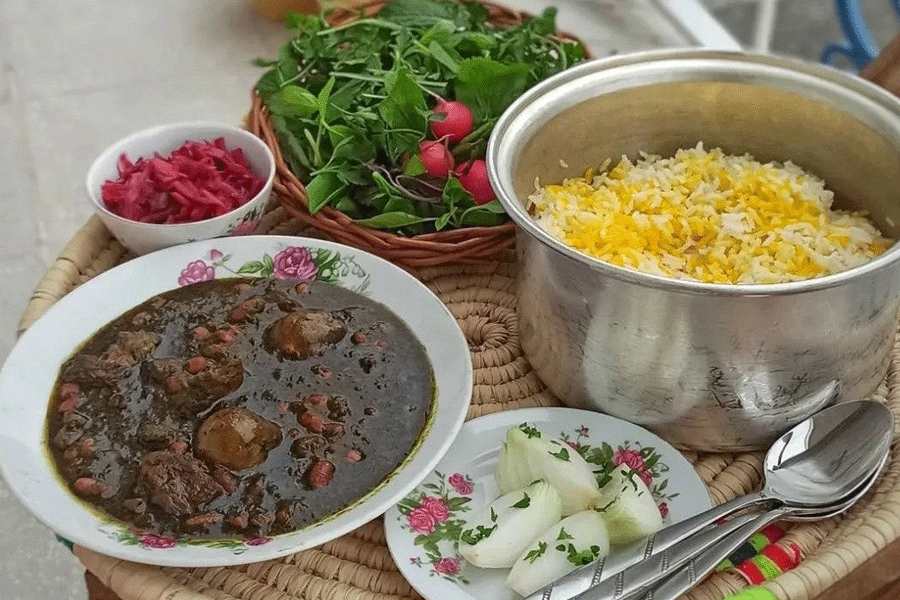
3. Khoresht-e Ghormeh Sabzi
Ask many Iranians about their favorite dish, and you’ll likely hear “Ghormeh Sabzi!” This cherished stew is crafted with a blend of aromatic herbs, onions, Omani lemon, red beans (or sometimes pinto or white beans), and a choice of sheep, veal, or lamb meat. The key to its rich flavor lies in the long, slow cooking process; the longer it simmers at a low temperature, the better it tastes. Typically served with plain or saffron rice, Ghormeh Sabzi offers an intriguing and delightful experience for international visitors.
It’s worth noting that Ghormeh Sabzi also hails from northern Iran, a region renowned for its natural beauty and abundant aromatic vegetables. These fresh, local ingredients contribute to the stew’s signature heavenly fragrance and flavor, making it truly special.
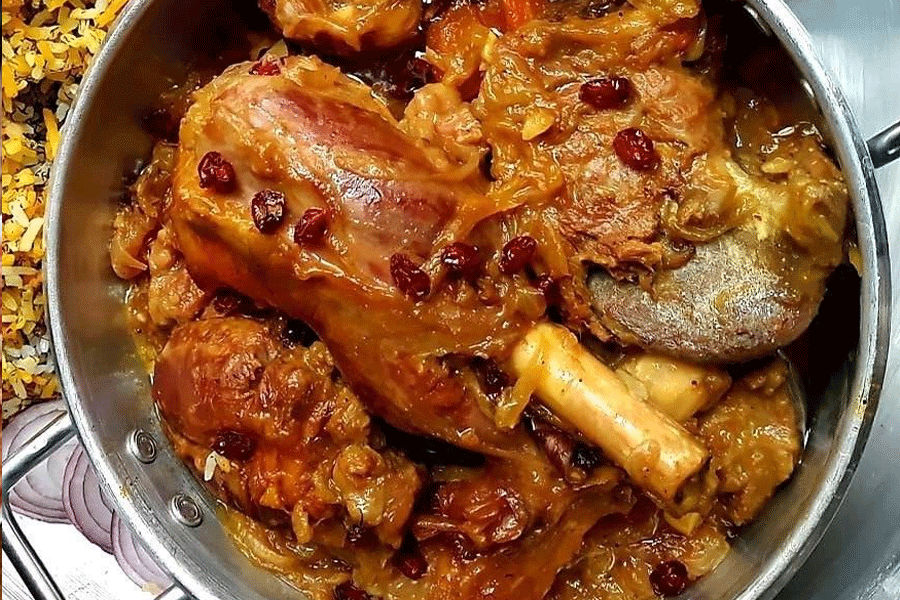
4. Sabzi Polo or Baghali Polo ba Mahicheh
Sabzi Polo, especially when served with meat, is a favorite among both Iranians and international diners. This dish combines white rice with saffron and fresh dill (though dried dill is also acceptable). It’s typically accompanied by tender sheep meat or chicken, creating a flavorful and beloved meal.
Baghali Polo is similar to Sabzi Polo, with the key difference being the addition of broad beans (Baghali). These beans, whether fresh or dried, are mixed into the rice, and the dish is served in the same manner. Baghali Polo with meat (Mahicheh) is often considered a premium dish and is featured in high-end restaurants.
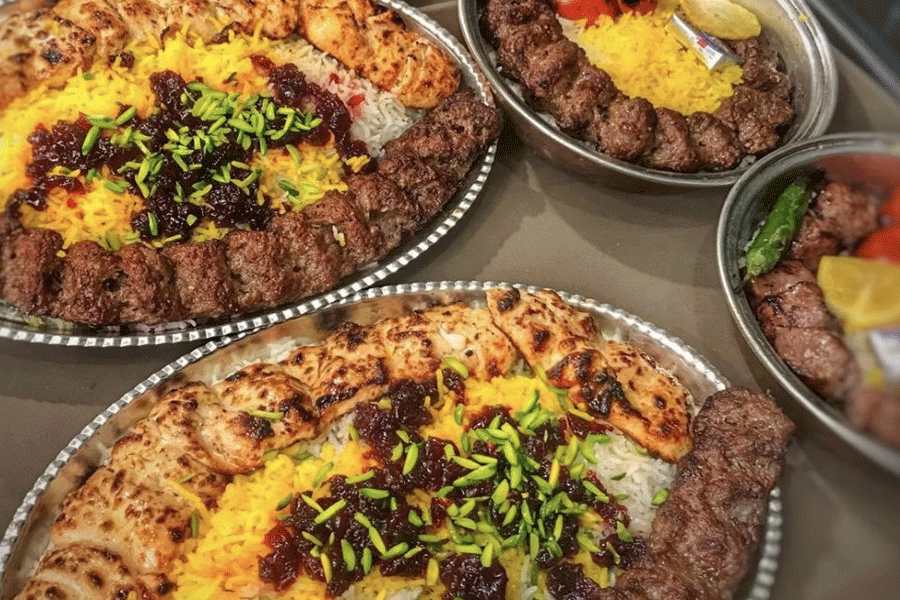
5. Chelo Kabab Koobideh
Chelo Kabab, which pairs kebab with rice, is arguably the most iconic Iranian dish, widely recognized as a symbol of Iranian cuisine. Among the various types of kebabs, Koobideh stands out for its popularity. This kebab is made from ground meat seasoned with minced onions, salt, and pepper. Another beloved variety is Kebab-e Barg, featuring sliced lamb or beef marinated with lemon juice, onions, saffron, and butter. Both types of kebabs are cherished by Iranians and visitors alike.
Typically, kebab is served with grilled tomatoes and peppers, saffron rice, and a refreshing yogurt-based drink called Dough. It’s also accompanied by fresh vegetables. Occasionally, Iranians enjoy Koobideh with bread instead of rice, adding a different but equally delicious touch to the meal.
6. Khoresht-e Gheimeh
Khoresht-e Gheimeh is another beloved Iranian dish. This stew is made by simmering minced meat with onions, split peas, tomato paste, Omani lemon, and water until fully cooked. Cinnamon and saffron are added for extra flavor and aroma. The dish is then topped with fried potatoes or eggplant and typically enjoyed with plain or saffron rice.
When Khoresht-e Gheimeh is served with fried potatoes, it’s known as Gheymeh Sibzamini. When paired with fried eggplant, it’s called Gheymeh Bademjan. Both variations offer unique and delicious twists on this classic Iranian stew.
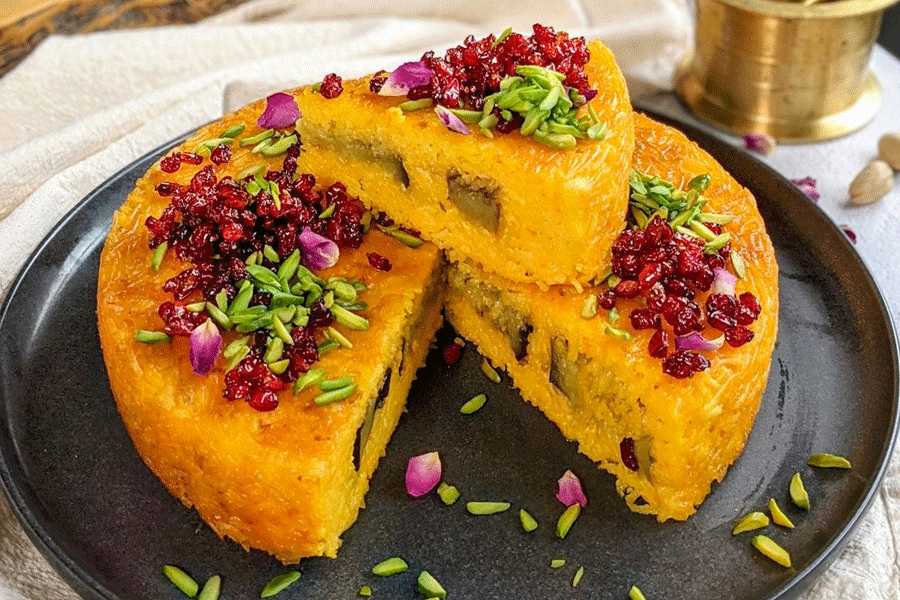
7. Tahchin
Tahchin is a stunning and flavorful Iranian dish, known for its elegant presentation. Its striking appearance has led some foreigners to refer to it as an “Iranian cake.” This dish is made with rice, yogurt, saffron, eggs, and chicken fillets. While variations with meat or eggplant exist, Tahchin with chicken is the most popular and well-known.
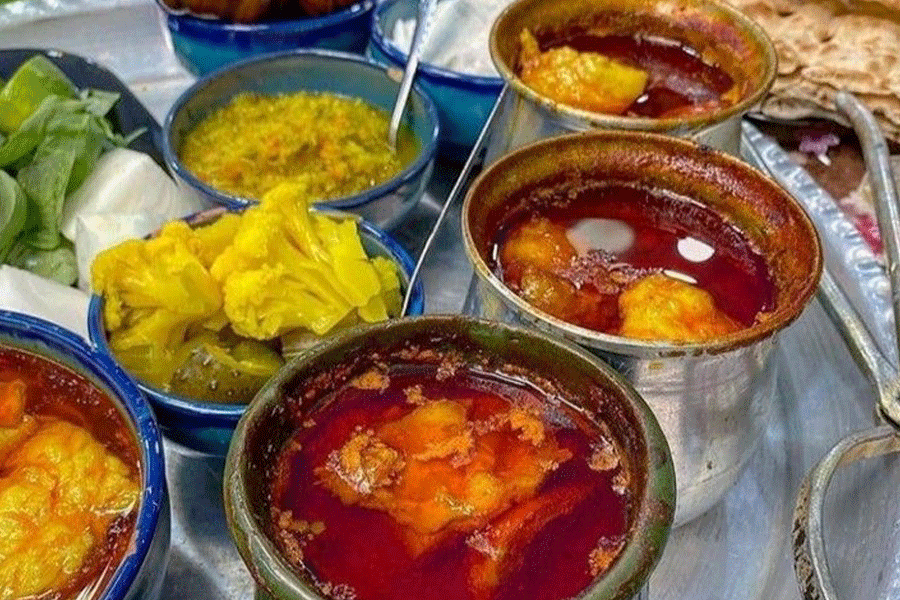
8. Abgoosht (Dizi)
Abgoosht, also known as Dizi, is a quintessential Iranian dish. It features lamb meat simmered with beans, onions, potatoes, and occasionally tomatoes until everything is tender and flavorful. Traditionally, it is served with bread, fresh vegetables, butter, yogurt or Dough, and onions, creating a hearty and satisfying meal.
The best way to enjoy Abgoosht is in traditional individual stone pots. Each person receives their own pot, pours the broth into a separate bowl, and soaks bread slices in it. This mixture is then eaten as a flavorful stew. The remaining ingredients are mashed with a stone masher and enjoyed separately. While this traditional method is highly recommended, you can certainly adapt the process to your own preferences.
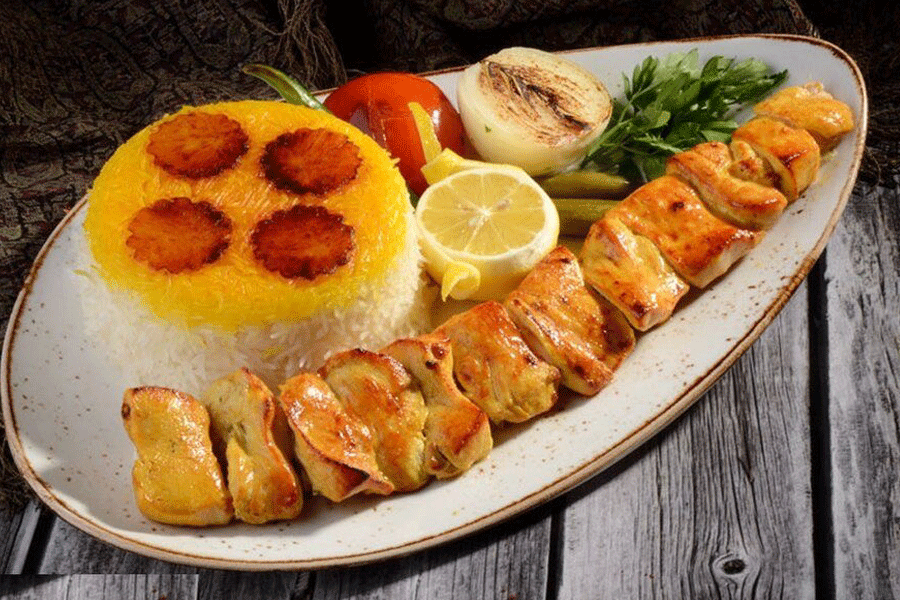
9. Persian Chicken Kebabs (Jujeh Kebab)
Iranians have a deep appreciation for meat, and chicken, along with lamb and veal, features prominently in their cuisine. One of the most delightful dishes is Jujeh Kebab, or grilled chicken, which is cooked over charcoal for a rich, smoky flavor. A cherished tradition is to prepare this kebab while camping in nature, grilling the chicken right on an open fire. Jujeh Kebab is typically served with grilled tomatoes, saffron rice, and butter, making for a delicious and satisfying meal.
Additionally, the chicken pieces are marinated in a mixture of grated onion, salt, and saffron before grilling. This marinade infuses the meat with extra flavor and enhances the overall deliciousness of the Jujeh Kebab.
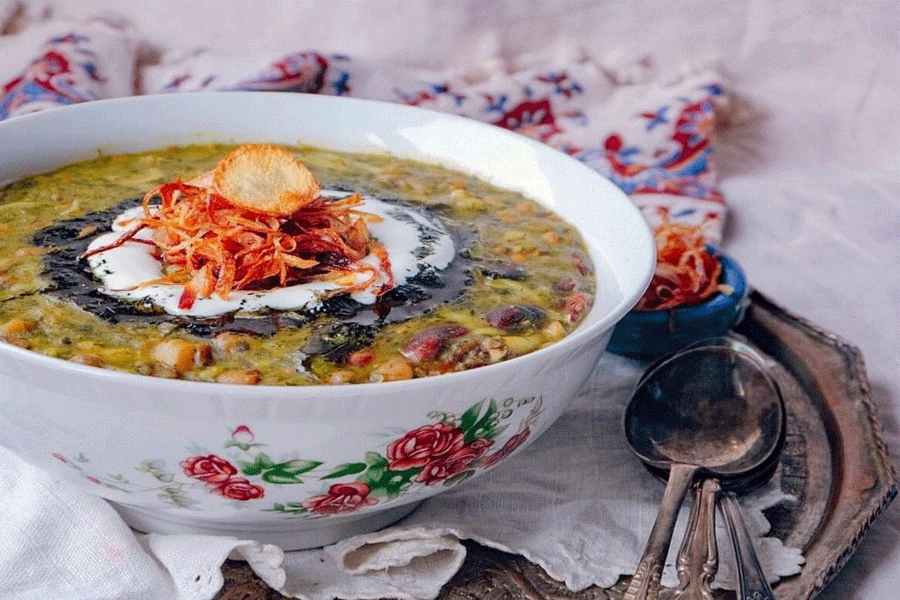
10. Ash Reshteh
Ash Reshteh is a traditional Iranian dish renowned for its comforting and hearty nature. Though it’s considered a simple dish, preparing Ash Reshteh requires a bit of effort in assembling the ingredients. This beloved soup varies in preparation across different cities. The recipe described here is one of the easiest methods to create a delicious Ash. It features a blend of vegetables such as spinach, coriander, parsley, dill, and leek—often sold as “Ash vegetables.” The quantity of beans and chickpeas can be adjusted to taste, and the dish is finished with the addition of noodles (Reshteh).
The topping is a crucial element of Ash Reshteh, and many Iranians take great care in decorating it. Common toppings include fried onions, fried garlic, fried mint, and Kashk, which is made from drained yogurt. These garnishes add both flavor and visual appeal to the dish.
Must-Try Dishes for Your Iranian Adventure
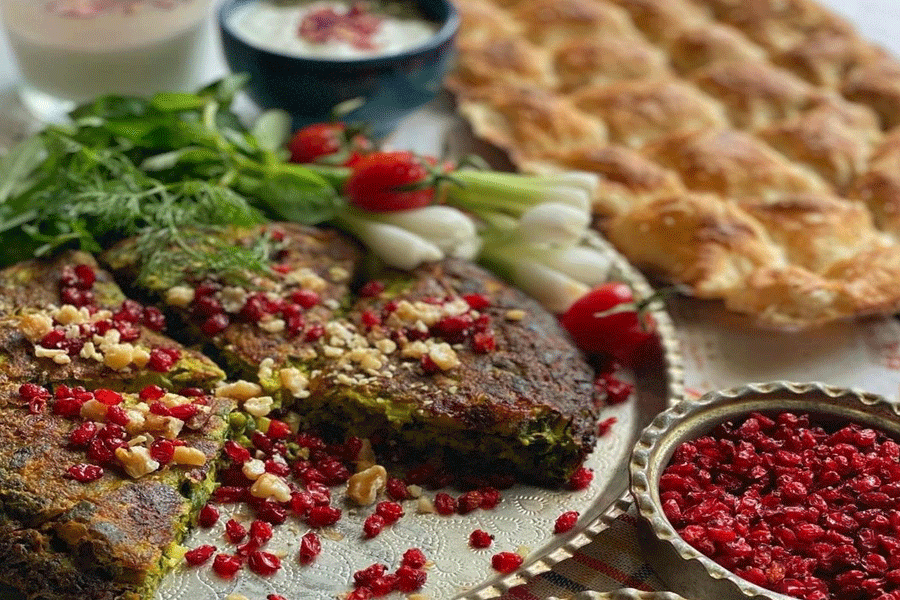
1. Kuku Sabzi
Kuku Sabzi is a beloved Iranian dish, often enjoyed for dinner or as a snack due to its simplicity and deliciousness. It is one of the most popular varieties of Kuku, primarily distinguished by its generous use of fresh herbs and vegetables. This vibrant dish is a must-try for anyone exploring Iranian cuisine.
Each city in Iran has its own version of Kuku Sabzi. For instance, people from Mazandaran might use different vegetables compared to those from Tabriz. Generally, the dish consists of eggs and aromatic herbs. To enhance its flavor, variations often include chopped walnuts, barberries, or beans, making it even more delicious.
2. Beryani
Beryani is a renowned and beloved dish from Isfahan that has gained popularity across Iran for its exceptional taste. Traditionally made with mutton, which imparts a rich flavor, it is also prepared with chicken in modern variations. This hearty and historic dish includes sheep meat, onions, sheep lungs, oil, turmeric, salt, and pepper. It is often garnished with walnuts and basil, and typically served with fresh vegetables, lime, and bread.
3. Albaloo Polo
Albaloo Polo is a striking and flavorful dish, often considered a ceremonial food in Iran and served at many parties and formal occasions. This delicious dish can be made with either red meat or chicken. Its vibrant cherry (albaloo) component adds both color and taste. Preparing Albaloo Polo requires a certain level of skill, and not everyone can master it perfectly.
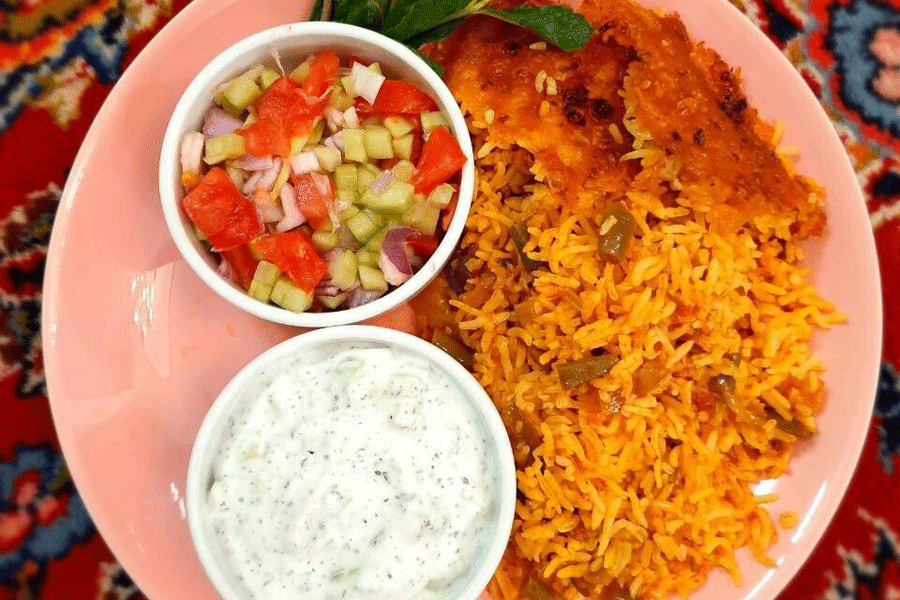
4. Lubia Polo (Loobia Polo)
Lubia Polo is a flavorful and beloved Iranian dish, known for its distinctive preparation and serving customs. It is commonly enjoyed with bread, potato tahdig (crispy rice), Shirazi salad, fresh vegetables, and yogurt, creating a delightful and well-rounded meal. The dish is made by combining rice with chopped green beans, ground meat, onions, tomato paste, and a blend of spices, all cooked slowly until perfectly tender.

5. Khoresh Bademjan
Eggplant, or Bademjan, is a favorite ingredient in Iranian cuisine, and one of the most delicious dishes featuring it is Khoresh Bademjan, or eggplant stew. This hearty stew involves cooking meat with onions and spices, then incorporating fried eggplants and a generous amount of sour grapes for added flavor. Khoresh Bademjan is typically served with white or saffron rice, making for a flavorful and satisfying meal.
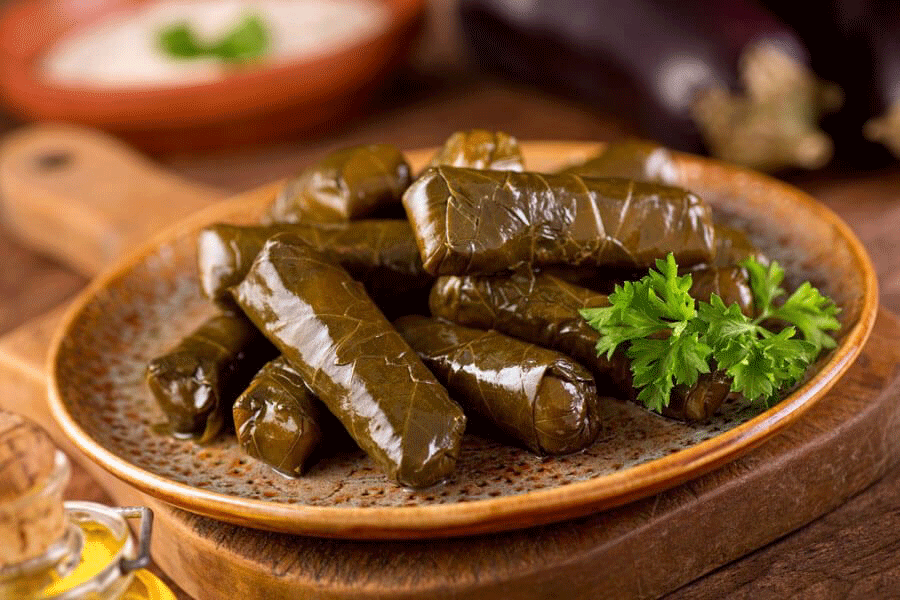
6. Dolmeh
Dolmeh encompasses a variety of stuffed dishes, with some of the most popular types being grape leaf dolma (Dolmeh Barg Mo), tomato dolma, eggplant dolma, and bell pepper dolma. Among these, Dolmeh Barg Mo is particularly favored and is often made in the spring when grape leaves are fresh, sour, and delicious. While traditionally associated with the West and East Azerbaijan provinces, dolmeh is now enjoyed throughout Iran. The filling typically includes a mix of ground meat, dolma vegetables, onions, split beans, and other ingredients.
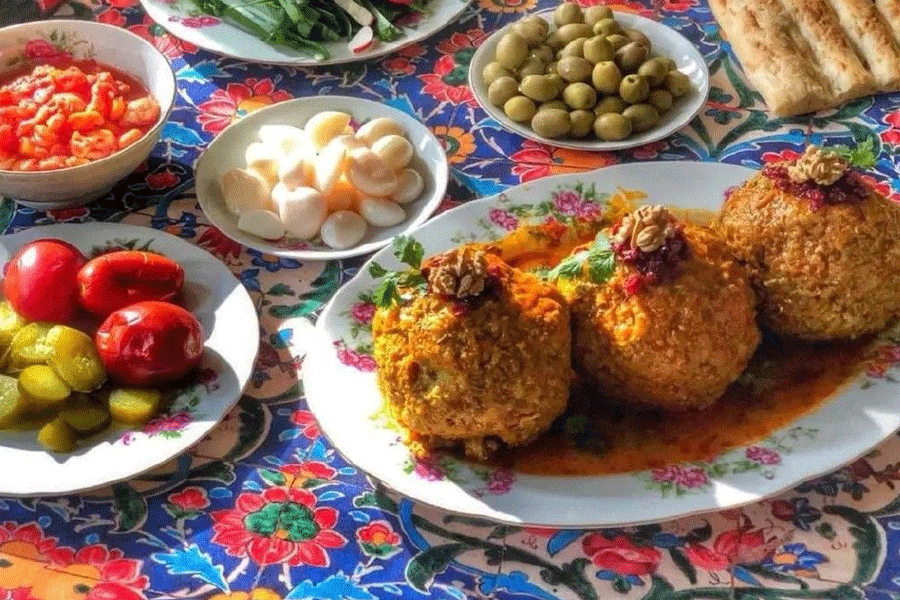
7. Kufteh Tabrizi
Kufteh Tabrizi, named after its city of origin, Tabriz, is now enjoyed across Iran and is renowned as one of the country’s most delicious dishes. This variation of meatballs stands out for its rich flavor and unique ingredients. The recipe typically includes a blend of meat, split beans, vegetables, hard-boiled eggs, plums, walnuts, fried onions, and barberries, making it a flavorful and hearty meal.
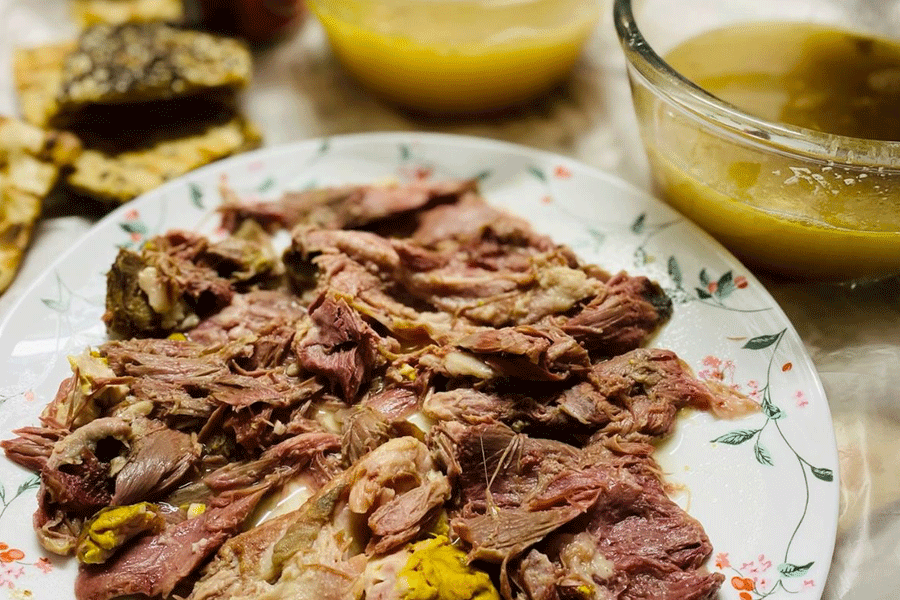
8. Kale Pache
Kale Pache is a time-honored dish cherished across the Middle East and South Caucasus, with each region adding its own touch to a shared culinary tradition. This age-old food remains popular, with many people visiting local eateries early in the morning to enjoy it. Kale Pache is known for being rich and hearty, but those with high blood fat, cholesterol, or uric acid levels, or those suffering from gout, should be cautious. Preparing Kale Pache requires time and skill to achieve the right texture and flavor.
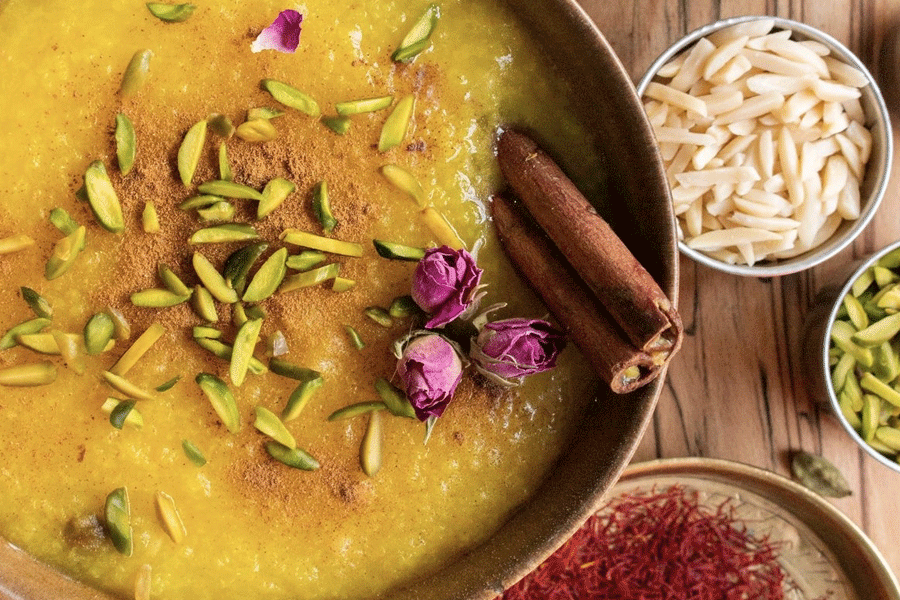
9. Sholeh Zard
Sholeh Zard is a traditional Iranian dessert made with rice, sugar, saffron, rose water, water, and oil. The preparation begins by boiling soaked rice in water until it becomes soft. Sugar syrup and ground saffron are then added, and once the mixture thickens, cardamom, rose water, and almond nuts are incorporated. The dish is topped with cinnamon, sliced almonds, pistachios, and coconut powder. Occasionally, grape syrup or honey is used as an alternative to sugar.

10. Mosama Khoresht
Mosama Khoresht, also known as Alu (plum) Mosama stew, is a popular and flavorful Iranian dish often served with rice. This stew can be prepared in various ways, with some of the best versions found in northern Iran. While it is commonly made with chicken, it can also be cooked with red meats like lamb or veal, though using a larger quantity of meat is necessary for red meat variations. Different types of plums can be used in the recipe, and adding a little water helps to balance the flavors.

